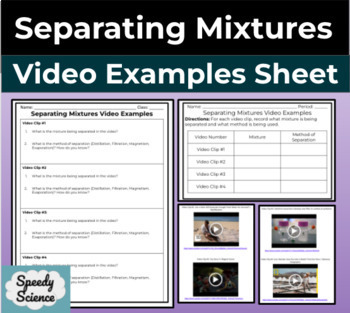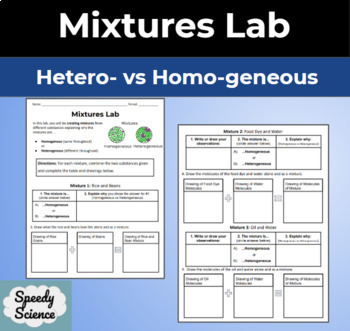Mixtures & Elements BUNDLE - Labs, Video Activities, Research, Readings, Quiz
- Google Slides™

Products in this Bundle (9)
showing 1-5 of 9 products
Description
Activities to review Elements & Mixtures! The Labs, Notes, Readings, and Assessments will provide an excellent addition to any unit on Matter.
Click through each included resource to learn more!
----
Separating Mixtures - Video Examples Sheet (Filtration, Distillation, Magnet...)
Students watch four videos that showcase an example of mixture separation and describe the type of mixture being separated and which method is being used to separate the mixture (Distillation, Filtration, Magnetism, Evaporation).
You can also choose different videos. I chose these for high-engagement and to showcase why we discuss mixture separation in the first place.
Full sheet included, or a shorter half-sheet condensed version. Google slides editable and printable.
Video Clip #1: Can a Solar Still Generate Enough Fresh Water for Survival? | MythBusters
https://www.youtube.com/watch?v=Zuj_NnymqMg&ab_channel=ScienceChannel
Distillation to separate freshwater from saltwater
Video Clip #2: Toy Story 3: Magnet Scene
https://www.youtube.com/watch?v=Na6-URHxOtU&ab_channel=TimothyLy
Magnetism to separate metals from trash
Video Clip #3: Stanford researchers develop new filter to combat air pollution
https://www.youtube.com/watch?v=1rbszixZy60&ab_channel=Stanford
Filtration to separate pollutants from the air
Video Clip #4: Ever Wonder How Sea Salt Is Made? Find Out Here | National Geographic
https://www.youtube.com/watch?v=0vVyw2rVA4Q&ab_channel=NationalGeographic
Evaporation to separate salt from saltwater
Mixtures Lab: Heterogeneous vs Homogeneous Models - Sheets
Lab sheet. Students will mix: rice and beans, food dye and water, oil and water. Simple, cheap lab to get students thinking about mixtures and pure substances.
In this lab, you will be creating mixtures from different substances explaining why the mixtures are…
- Homogeneous (same throughout) or
- Heterogeneous (different throughout)
Directions: For each mixture, combine the two substances given
and complete the table and drawings below.
1. The mixture is...
(circle answer below)
2. Explain why you chose the answer for #1.
(Homogeneous vs Heterogeneous)
-------------------------------------------------------------------------------------------------------------------
Earn TpT credits towards future purchases!
Login to your TpT account. Go to your My Purchases page. Beside each purchase you'll see a Provide Feedback button. Simply click it, give a quick rating and leave a short comment for that product. Each time you give feedback, TpT gives you credits that will save you $$ on future purchases.
----------------------------------------------------------------------------------------------------------------------
Want to download this resource as a PDF?
1) After purchasing, open the resource in Google Slides/Docs
2) Go to the menu on the top of the screen (under the title)
3) Click on File (first menu item from the left)
4) Click on Download
5) Choose PDF Document (.pdf)
OR… You can also email me at speedysciencelessons@gmail.com with proof of purchase if you prefer that I send you the PDF directly.





